| Zeitschrift Umělec 2000/5 >> Prague Street Clashes as a Major Work OF Art | Übersicht aller Ausgaben | ||||||||||||
|
|||||||||||||
Prague Street Clashes as a Major Work OF ArtZeitschrift Umělec 2000/501.05.2000 Barbara Schurz, Alexander Brener | focus | en cs |
|||||||||||||
|
"On 26 September 2000, several thousands demonstrators realized a truly magnificent work of art in Prague—a demonstration that lead to street clashes with the police and a number of broken windows. Long live artistic production! We however wish to postulate that this event, pulsating like the heart of a sperm whale aboard a whaler, was not part of the slowly expiring 20th century. It was already a part of the unknown, imagination engaging, oceanic 21st century. Yes, that’s right. The disturbances in downtown Prague were not just the sad relics of history; they marked the beginning of something new, something ever reviving, something called anarchism…. We’d like to believe it…. Anarchists never speak of their plans, and they do not respect art. We declare right now: The Prague masterpiece meets all the theoretical requirements that we, the authors of this text, pose upon current works of art. First, the event in Prague—as is appropriate for an anarchist action—raised profound dissatisfaction among the governing establishment, Czech state power and the highest ranks of the international liberal-capitalist elite. (Even the FBI was piqued.) Financial tycoons and police jackals smirked with disgust and twisted with anger. This is, no doubt, the main effect and the crucial objective of current art: to cause dissatisfaction that penetrates the souls of the filthy rich and the yesmen. This abrading, draining dissatisfaction is simply necessary! We emphasize once again: The demonstrators in Prague caused the new bourgeoisie stomach cramps.
Second, the Prague disturbances were collective in nature, which is excellent news indeed. Let’s quote Lautremont at this point who said, “Poetry must be made by everybody and not by individuals.” This is certainly true, and the Prague disturbances proved so. We should not forget that the art of the self-proclaimed “professionals” of today’s multicultural elite is nothing but a laughing representation of the current cynical “Lords of Life,” the neo-liberal big guns. To hell with all “professionals!” Only the collective volcanic activity that focuses on destroying the property of those owners is capable of full-scope expression in culture. Destroy capitalist ownership! Let the destruction roll wave after wave like the storms of demonstrators against the police defense walls. Anarchist activities are based on the principal of being reasonless, yet at the same time they smear this principle. These activities not only arbitrarily set their own end but also their beginning…. When an anarchist wave rolls over you, the previous waves become something distant, cast off into the past. The new beginning is more categorical, more dangerous, more frightening…. Whatever is past however does not disappear for good. Like the unexpected pick of a knifepoint, it evokes the fury of the present. And finally the third significant feature of the Prague masterpiece is its resistance to technology. What does this mean? Let’s analyze this…. Demonstrators naturally used a number of various technologies. They formed blocks; they made banners; they shouted slogans; they dug out pavement blocks; they hurled Molotov cocktails at the police; and they created barricades. All of these are indeed various forms of technology. We understand this resistance to technology as something different. It is a vital parting from the ideology of technology, disrupting and negating this ideology through such physical acts as clashes with the police and the destruction of property. The real problem the activists had to face was standing up to the police structure as the highest and utterly apparent embodiment of the hierarchical thinking that is standard for the state and society. It is this thinking that guarantees the continuous “progress” of technology! Standing up to the police thus represents an attempt at parting with the hegemonic tradition that, in its own historical development, relies on such categories as the sacred and mythology, God and symbol, reason and sign, sense and structure, and so on. The problem was in challenging syllogism and morale, humanism and romanticism, the “conscious” and the “unwilling,” the “human” and the “arts!” It’s clear that not all activists formulate their activities using such terms…. It’s not even necessary…. Resistance to technology is not a simple analysis and critique of one or another institution or mechanism; it is changing criticism into a hyper-fast operation that is not centrally controlled but stems from the heart of the active void, or, one could say, from all points of the heavy ocean. Is that clear?! If not, masturbate and try reading these lines again during orgasm…. But for now, forget about the nonsense of “art” and “masterpiece” and so on. What happened in Prague on September 26 was politics and nothing but politics. We understand politics as a call for the oppressed groups and individuals (and those expelled to the periphery) to fight against the current power structures. Only as the call itself becomes a physical act can real political activity be realized. Politics is thus not the meetings of the official representatives of the IMF and World Bank; politics is stones hurled at the police. Let’s come up with a few facts and social-political aspects of the Prague demonstrations. We will pose them in the form of questions, which we will then briefly try to answer. The questions and answers are mainly useful to us, for our reflections and our practical resistance. We give no advice here; we are simply trying to come to terms with what happened. (We are referring here to the “humiliation of speaking for others” mentioned by Foucault. We speak only for ourselves.) 1. What do the IMF and the World Bank, against which the “S 26” event and the “Global Day of Actions” demonstration were organized in Prague (and other cities), actually represent? The IMF and World Bank are transnational and globalized bodies of capitalism. They provide various countries (including “post-communist” and “developing” countries) loans and programs of structural adaptation, which transform the economies of those countries towards neo-liberal plundering. They absolutely don’t fight poverty—a stand they attempt to foist on society; on the contrary, they increase the destitution of the poor, and they continue to care for the wealth of the wealthy. They block alternative (non-capitalist) initiatives and embody new capitalism. 2. Who are the so-called “opponents of globalization?” Who took part in the demonstrations? Almost nobody really considers himself or herself an opponent to globalization. This represents the uncritical labeling of the media, which conceals that we’re talking about the globalization of capitalism. The range of various groups and individuals is wide and varied. The main organizer in Prague was INPEG (Initiative Against Economic Globalization), which is a collective of various groups. There were environmentalists, human rights activists, autonomous groups, and anarchists among others. The demonstrations also saw the presence of other groups and collectives: Christian groups (Jubilee 2000), Trotskyites, Leninists, feminist groups, workers unions…. There were also representatives of groups fighting for the rights of the “third world,” individual anarchists, and “legal observers.” Present also were people wearing Nike sneakers who identified with the oppressed…. This was reflected in the variety of the demonstrators’ demands, which ranged from moderate calls for reform and the abolishment of the debts of the poorest countries (“Drop the Debt!”, “Smash IMF/WB”) to the vandalism of private property, which in turn implied the destruction of the entire capitalist empire (“Abolish Capitalism!”). 3. Who believes in dialogue and negotiation and who does not? Demonstrators often discussed the question of whether there should be dialogue with capitalists. The majority of activists understand that so-called dialogue is not possible and that any dialogue would only lead to unpleasant media communication which serves only those in power and nobody else. The idea of dialogue is one standard “facade” of representative democracy, which masks the cynicism of the powerful and the powerlessness of the oppressed. Václav Havel organized a “dialogue” between the head of the IMF, Horst Köhler; president of the World Bank, James Wolfensohn; George Soros; and representatives of non-governmental organizations at the Prague Castle on September 23. Some of the activists who were supposed to represent INPEG, however, were actually denied entrance to the Czech Republic. The discussions, with statements to the tune of, “We all want basically the same: to fight poverty,” and, “I have a heart, too” tasted like sugarcoated phlegm, nothing more. 4. How did the official mass media report the events in Prague, and what was their actual role? The official media do not provide “independent,” “objective,” and “neutral” news coverage. The mass media only serve those in power—either openly and cynically or unintentionally and cowardly. The mass media disseminate the propaganda of the Czech Ministry of Interior and hysterically support the police and their brutal revenge on demonstrators and all those they consider demonstrators. The media conceal facts about the circumstances of the mass arrests. It is obvious that this does not concern all media in the same way. 5. Violence. Who used violence in Prague? The demonstrators who hurled stones and broke glass or the representatives of those in power? The general awareness (as well as the official version of the events) associates all violence with cobblestones flying at the police—i.e., with the demonstrators. However there is no question that systematic violence (both brutal and subtle) is generated by capitalism and its guardsmen, not by political and social movements. And this was the case in Prague. On the morning of September 26, 422 demonstrators were arrested with another 892 arrested on September 28. The police beat the demonstrators and denied them their basic rights (the right to consult a lawyer, to use the telephone, to get food, etc.). In the meantime, the number of arrested jumped up to 950 of which “only” 25 were indicted. 6. Was the Prague operation successful? When comparing the demonstration in Prague to what took place in Seattle (where protest partially thwarted the World Trade Organization’s conference in 1999), we could say that the “surprise” of resistance did not happen. Verve, the enthusiasm of the masses and a certain destructive intensity were missing here. On the other hand, there were 11,000 specially trained police officers and 1,600 soldiers roving about town ready for any scenario. The schools were closed for a week and the neighborhood around the congress center was under constant surveillance. All of this was missing in Seattle. The list of unwelcome persons and other measures prevented many activists from entering the Czech Republic. This means that preventive police measures were enforced, which had a negative impact on the situation. Contrary to expectations, the number of protesters didn’t reach 20,000. Despite all this, the Prague demonstrations were successful. Does it seem ridiculous? Oh, no! We say once again: September 26 proved that there is a political force in the world that is ready throw itself into open conflict with those in power. This is not insignificant! Yes, yes! DOWN WITH ALL FENCES, WALLS AND PRISONS! DOWN WITH PRISON SENTENCES! DOWN WITH BORDER PATROLS AND PASSPORT CONTROLS! LONG LIVE THE FREEDOM OF MOVEMENT OF ALL INDIVIDUALS! LONG LIVE THE REMOVAL OF POLICE AND INSTITUTIONAL CONTROL OF ALL KINDS! LONG LIVE THE UNIVERSAL ABOLISHMENT OF ALL STATE BORDERS! DOWN WITH RIGHT-WING BIG-MOUTHED POLITICIANS! DOWN WITH LIBERAL BIG-MOUTHED POLITICIANS! DOWN WITH ALL BIG-MOUTHED POLITICIANS! LONG LIVE THE INTERNATIONAL SOLIDARITY OF RESISTANCE! LONG LIVE VARIOUS FORMS AND DIFFERENCES OF RESISTANCE! LONG LIVE THE IMPLACABILITY AND AGGRESSION OF ENDLESSLY VARIED RESISTANCIES! DOWN WITH BRUTAL RACISM! DOWN WITH RACISM CONCEALED BEHIND TOLERANCE AND GOODWILL! DOWN WITH THE CONSCIOUS AND UNCONSCIOUS RACISM OF INDIVIDUALS AND THE DULL MASSES! LONG LIVE POLITICAL ANTAGONISM REVEALING XENOPHOBIA, INEQUALITY AND THE VIOLENCE OF THOSE IN POWER! LONG LIVE CONFLICTS REVEALING HIDDEN POWER RELATIONS AND THE CONDITIONS OF THE OPPRESSED! LONG LIVE THE OPEN CLASH BETWEEN THE POWER AND THE RESISTANCE! DOWN WITH SEXISM AND DISCRIMINATION WITHIN THE RESISTANCE MOVEMENT! DOWN WITH ANY TITLES TO POWER AND DICTATOR MANNERISMS IN THE RESISTANCE MOVEMENT! DOWN WITH LEADERSHIP AND INTRIGUES IN THE RESISTANCE CAMP! LONG LIVE RESISTANCE IN THE ACTUAL (PROFESSIONAL) ENVIRONMENT! LONG LIVE RESISTANCE TO DOMINATION AND THE OPPRESSION OF THE RESISTANCE MOVEMENT! LONG LIVE EQUALITY, SOVEREIGNTY AND THE NON-EXISTENCE OF POWER! DOWN WITH NEO-LIBERALISM WHOSE POLITICS SUPPORT THE REBIRTH OF FASCISM! DOWN WITH THE STATE WHICH APPROVES BURTALITY OF THE FASCISTOID POLICE! LONG LIVE THE CREATIVITY OF THE INDIVIDUAL REVOLT AND COLLECTIVE DISOBEDIENCE! LONG LIVE THE POLITICAL IMAGINATION AND COURAGE! LONG LIVE LOCAL AND SPECIFIC STRATEGIES AND THE TACTICS OF RESISTANCE! DOWN WITH PASSIVITY AND BEDEVILMENT BY THOSE IN POWER! DOWN WITH PESSIMISTIC MINORITY COMPLACENCY WITH COMPROMISES TO THE REPRESSIVE MORAL MAJORITY! DOWN WITH THE POWERLESS POLITICS OF APPEASEMENT AND NORMALIZATION! LONG LIVE DECENTRALIZATION AND THE SELF-ORGANIZATION OF RESISTANCE! LONG LIVE POLITICAL EXPERIMENT LEADING TO THE INTERNATIONAL SOLIDARITY OF ALL THE OPPRESSED! LONG LIVE THE ULTIMATE RIGHT, THE RIGHT OF ANYONE TO REVOLT! Kresby / illustrations by A. Brener & B. Schurz , 2000, Translated by Vladan Šír "
01.05.2000
Empfohlene Artikel
|
|||||||||||||
|
04.02.2020 10:17
Letošní 50. ročník Art Basel přilákal celkem 93 000 návštěvníků a sběratelů z 80 zemí světa. 290 prémiových galerií představilo umělecká díla od počátku 20. století až po současnost. Hlavní sektor přehlídky, tradičně v prvním patře výstavního prostoru, představil 232 předních galerií z celého světa nabízející umění nejvyšší kvality. Veletrh ukázal vzestupný trend prodeje prostřednictvím galerií jak soukromým sbírkám, tak i institucím. Kromě hlavního veletrhu stály za návštěvu i ty přidružené: Volta, Liste a Photo Basel, k tomu doprovodné programy a výstavy v místních institucích, které kvalitou daleko přesahují hranice města tj. Kunsthalle Basel, Kunstmuseum, Tinguely muzeum nebo Fondation Beyeler.
|







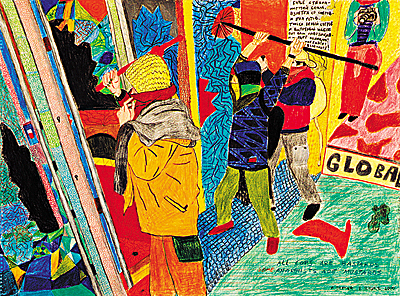

















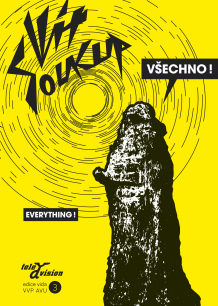




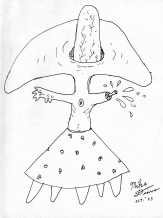
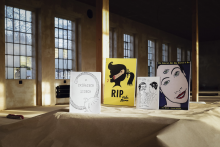
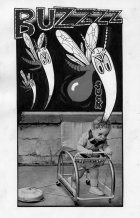



 Potsdamer Str. 161 | Neu Divus in Zwitschermaschine, galerie und buchhandlug in Berlin! | Mit U2 nach Bülowstraße
Potsdamer Str. 161 | Neu Divus in Zwitschermaschine, galerie und buchhandlug in Berlin! | Mit U2 nach Bülowstraße
Kommentar
Der Artikel ist bisher nicht kommentiert wordenNeuen Kommentar einfügen